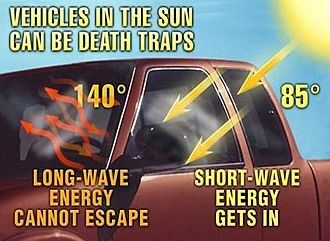How to Protect Animals from Heat Stroke

The sight of an animal sitting inside a car usually horrifies pet advocators. The concern derives from the knowledge that animals are prone to suffer from heat stroke, which oftentimes results in a slow and painful death.
What is Heat Stroke?
Heat stroke sets in when a warm-blooded animal is no longer able to self-regulate its body temperature due to environmental exposure. This should not be confused with a fever due to illness. The most popular pets, such as dogs and cats, do not have the ability to sweat, like humans. Therefore, they rely heavily on panting. When the environmental temperature exceeds what the animal is able to process, it can cause hyperthermia, or the inability to cool down, and typically starts to occur when the animal's body temperature reaches 104°F (40°C). When an animal experiences heat stroke, organs start shutting down and can result in long-term health problems or death.
The most common contributor to heat stroke is leaving an animal in a car during warm weather months. It is common for cars to exceed an internal temperature of 120°F (49°C). Many believe that cracking a window is sufficient to prevent heat stroke. This is an inaccurate assumption. A crack in one window allows more hot air to filter into the vehicle and circulates the heat inside. This can actually make the car warmer, rather than cool it down.
What are the Symptoms?
Prevention:
The ideal solution is to leave the animal at home, inside a temperature-controlled environment. In other words, avoid bringing animals along to run errands. However, in the event that animal travel is unavoidable, here are some extra precautions to take.
What is Heat Stroke?
Heat stroke sets in when a warm-blooded animal is no longer able to self-regulate its body temperature due to environmental exposure. This should not be confused with a fever due to illness. The most popular pets, such as dogs and cats, do not have the ability to sweat, like humans. Therefore, they rely heavily on panting. When the environmental temperature exceeds what the animal is able to process, it can cause hyperthermia, or the inability to cool down, and typically starts to occur when the animal's body temperature reaches 104°F (40°C). When an animal experiences heat stroke, organs start shutting down and can result in long-term health problems or death.
The most common contributor to heat stroke is leaving an animal in a car during warm weather months. It is common for cars to exceed an internal temperature of 120°F (49°C). Many believe that cracking a window is sufficient to prevent heat stroke. This is an inaccurate assumption. A crack in one window allows more hot air to filter into the vehicle and circulates the heat inside. This can actually make the car warmer, rather than cool it down.
What are the Symptoms?
- If an animal is unable to stop panting, even when in a restful state, such as lying down, this indicates the animal is in distress.
- If gums have turned either brick red or are paler than the standard salmon color, this indicates that the animal is experiencing physical shock.
- If the animal is lethargic, or unable to move, and has been exposed to excessive environmental temperatures, this would indicate heat stroke.
Prevention:
The ideal solution is to leave the animal at home, inside a temperature-controlled environment. In other words, avoid bringing animals along to run errands. However, in the event that animal travel is unavoidable, here are some extra precautions to take.
- Invest in a solar shield blanket.
- Ventilation Tailgate locks are available for most SUVs, which allows for increased airflow.
- Use a windshield solar blocker.
- For smaller animals, there are kennels with portable fans on them.
- Fill a cooler with bottles of water, ice cubes, and towels. Push car seats forward and layout a dampened towel. Hot air rises and cool air sinks. This means that the floor is the coolest location in a vehicle. Place a bowl of water on the towel and put some ice cubes in and around the bowl.
- Do not feed animal in the heat or just prior to travel. This helps curb carsickness, which can cause dehydration in hot weather. This is a particularly important point if long distance travel is involved. Plan to incorporate an hour outside the vehicle for the animal after meals.
- Run the air conditioning unit until air temperature is cool and park in a shaded area.
- Open all windows not just one. Make it small enough so the animal cannot jump out, but more than a tiny crack to allow for a cross-breeze. This helps generate productive air movement.
- Be very quick to finish errands, as heat stroke can occur within minutes.
- Shop at pet-friendly stores that allow animals to accompany shoppers, and bring the animal along on the shopping excursion.
- Bring animal into the house before unloading items from a vehicle.
You Should Also Read:
How to Handle Flea, Tick, and Lice Issues
What You Should Know About Cat Declawing
How to Avoid Deadly Animal Treats

Related Articles
Editor's Picks Articles
Top Ten Articles
Previous Features
Site Map
Follow @WildlifeWelfare
Tweet
Content copyright © 2023 by Deb Duxbury. All rights reserved.
This content was written by Deb Duxbury. If you wish to use this content in any manner, you need written permission. Contact Deb Duxbury for details.







